
|
|

|
YOU ARE HERE:>> General Information>>Scarabs by Franco Magnarini, page 4
THE GUIDANCE TOWARD THE GOOD
This scarab belongs to the group which have pious phrases mentioning the god Amon.
Drioton1 describes the sense of these compositions like this:
...Dieu était ainsi pour l'homme pieux la guide de toutes ses actions, et c'etait là le chemin de Vie, auquel diverses sentences se réferent plus o moins explicitement.
It is in a glazed steatite faded to light brown; measures 18x13x7 mm and has Tufnell classification2 C7/vIv/d5.
The prothorax is divided from the elytra by a Y-trace. The wing-cases are bordered and provided with U-marks. Legs mid-high, deeply carved, fully hatched and undercut through between fore and mid legs. The loss on the left does not prevent us from recognizing the partially lost nfr sign.
The engraving is deep with rounded sections, slightly different in depth (the sacred bark more deeply hollowed).
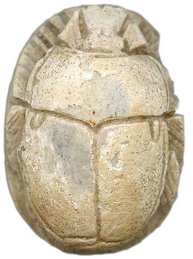

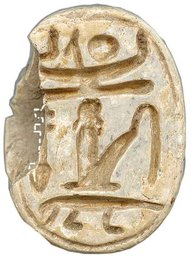
Vertically arranged, the motif shows the sinistrorsal (spiraling upwards from the left) writing:
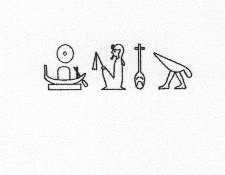
The cryptic meaning of the present composition is translated in a different way by various people.
Drioton1 translates the same item in Newberry3: "C'est Amon-Ra qui est la guide du bien".
Petrie4 translates: "May Ra lead the excellent king". Hornung5 limits itself to point out that it's a matter of "the good government system" referred to Amon.
As often it happens, the various translations of this type of writing do not fully agree.
We are inclined to the Drioton's translation, who has devoted a deep study to these maxims of piety: "It's Amon the guidance (toward) the good".
As to an attempt at dating, some clues direct us to the Late Period. The Y-shaped division between prothorax and elytra, the sacred bark with solar disc as a cryptogram of Amon, cutting though between fore and mid legs and, finally, the fashion of these sentences of piety, are all features which werea in vogue in that period.
1 Drioton E., "PAGES D'EGYPTOLOGIE", Le Caire, 1957, p. 126.
2 Tufnell O., "STUDIES ON SCARAB SEALS" vol. 2, part 1 Warminster, UK - 1984, 32-37 (we adopt this classification method because it seems to us the most appropriate to typological description, even if it has been conceived for Second Intermediate Period scarabs).
3 Newberry P.E., "SCARABS...", London - 1906, pl. XXIXI, 23.
4 Flinders Petrie W.M., "BUTTON AND DESIGN SCARABS"-1925, XII, 647.
5 Hornung E.-Staehlin E., "SKARABÄEN UND ANDERE SIEGELAMULETTE AUS BASLER SAMMLUNGEN" Basel -1976, p.393, D25.
THE KING SEKHAENRE: A RARE WRITING OF HIS NAME
This scarab is in grey steatite covered with a blue glaze partially vanished.
It measures 16 x 12 x –7 mm and has a Tufnell classification1 D6/O/e11.
The vertically arranged motifs show the prenomen of a king of the Second Intermediate Period . Ryholt deems it to be the first ruler of the XIVth Dynasty. Other scholars ascribe him to the XIIIth. Olga Tufnell quotes Sekhaenre among the rulers of the XV Dinasty2. On the whole, we know very little about this person.
The whole composition, inserted between two --- | |--- motifs3, reads:
Ntr nfr S-kha-n-(re) = the good god Sekhaenre
("The one whom Re has caused to appear") (Yakbim).
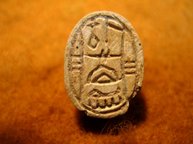
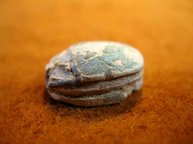
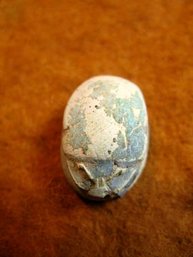
It is not certain that the prenomen Sekhaenre belongs to Yakbim: the two names have generally been identified as belonging to one king on the basis of the similarities between the scarabs.
Many items of this particular type are known4 but this one shows a variant of the writing: the absense of the sun disc sign above the S sign (a defective prenomen, but it is not the only one known).
The other example, of the same size, does have the sun disc sign. It's Tufnell classification is B2/O/e11
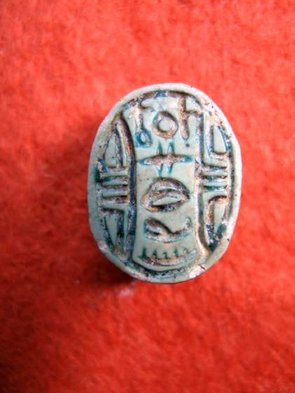
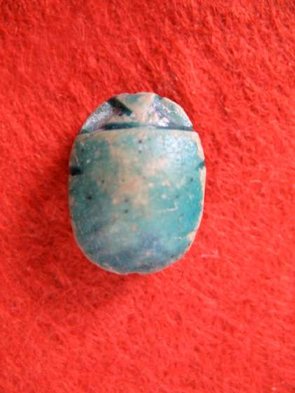
1Tufnell O., "STUDIES ON SCARAB SEALS" vol. 2, part 1 Warminster, UK - 1984, 32-37 (we adopt this classification method because it seems to us the most appropriate to typological description, even if it has been conceived for Second Intermediate Period scarabs).
2 Tufnell O., "STUDIES ON SCARAB SEALS" vol. 2, part 1 Warminster, UK - 1984, p. 162 and following.
3 Probably stylized reversed pairs of ntr signs the top of which have been fused together into a series of parallel horizontal strokes.
4 See - Hall H.R., "CATALOGUE", London -1913, 276, 277, 278.
- Flinders Petrie W.M., "SCARABS AND CYLINDERS WITH NAMES"-1917, XXII, 1, 2, 3, 4, 5, 6, 7, 8.
- Matouk F.S., "CORPUS DU SCARABEE EGYPTIEN vol 1, Les scarabées royaux - 1971, 182, 232; 208,182.
-Tufnell O., "STUDIES ON SCARAB SEALS" vol. 2, part 2 Warminster, UK-1984, 379, pl. LX, 3380-3392; 381, pl.LXI 3393-3415.
- Petrie Museum, London, Cat. UC11799, UC11800, UC 11801, UC 11802


Home | About This Site | Privacy Statement | Gallery | Testimonials | Guarantees
About Collectors' Resources pages | What's New
Search | Site Map | Contact Us